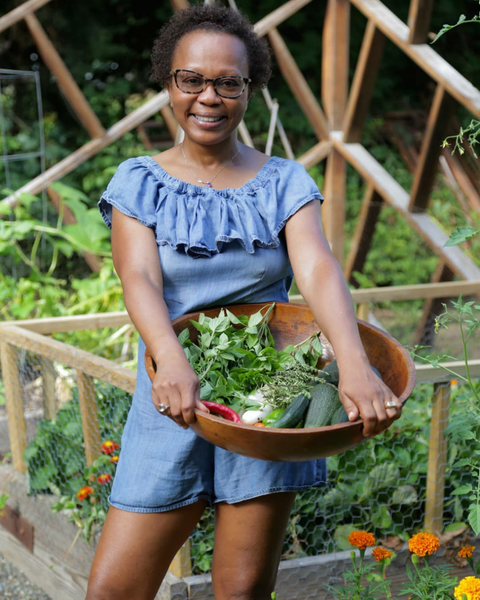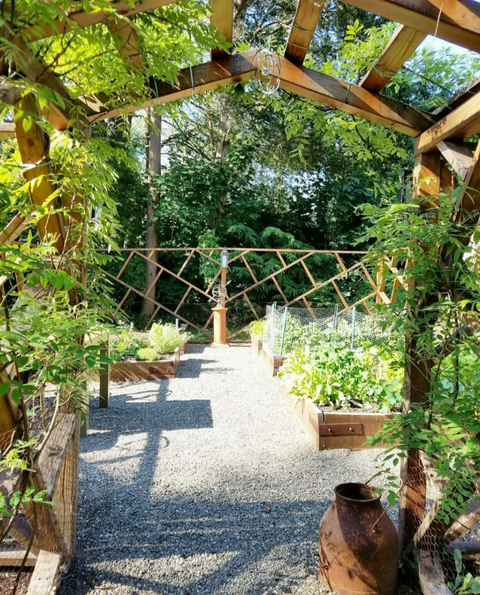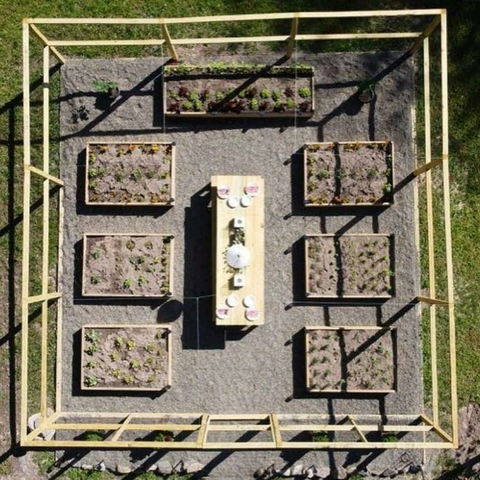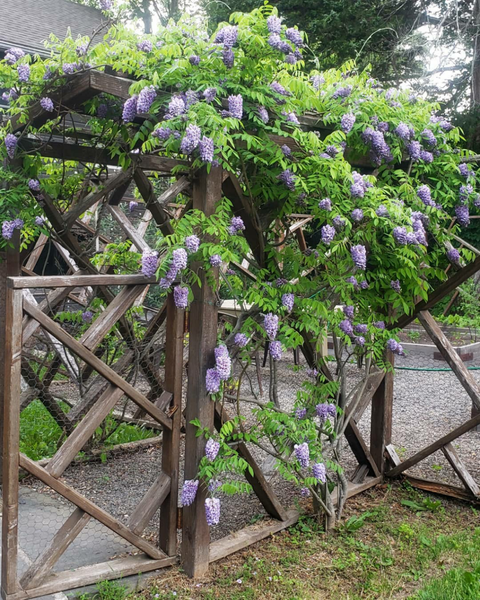Maryline Damour is founder of design-build firm Damour Drake as well as the Kingston Design Connection. She's also an avid gardener and chef. In this series, she connects the dots between gardening and interior design.
The past year, combined with increased awareness about climate change, has led many of us to focus on being more self-sufficient. One of the best ways to do that? Growing our own food. Last year, my own vegetable garden doubled in size when I became less than enthusiastic about shopping in supermarkets. The change amped up my cooking, but it also made me think about how we approach gardens. Growing food is a practical way to create your own resources, but that doesn't mean it can't be high design; in fact, in designing vegetable gardens, I apply the same principles I do when considering interiors. Here's how that shapes my garden—and how you can take the same approach.
Define your exterior spaces
While we may not be putting up drywall outside, that doesn't mean you shouldn't define the spaces—and their materials—like you would indoors. In gardens, we have options for 'flooring', including pea gravel, grass and mulch. Each has its own characteristic (pea gravel gives a good foot massage, while grass blends into the landscape). Exterior walls, meanwhile, can take the form of fencing or plant material. In my garden, I designed a trellis fence structure that is both decorative and functional: I plant zucchini, cucumbers and other climbing vegetables close to this fence so I can use it for support as the vegetables grow (while also adding a textural element to the fence design).
The wall has a protective purpose, too: The bottom half of the fence is wrapped in chicken wire and buried a foot underground to repel rabbits, groundhogs and other burrowing creatures.
Create a layout
While ceilings don't play a role in most garden designs, a well-defined entrance is as important in outdoor spaces as it is in interiors. This effect can be created with a gate, pergola, or even a path that gently guides you to the garden and suggests flow.
Want beautiful homes? We’ve got plenty. Let’s swoon over them together.
Find the right arrangement
Another key aspect of design is placement, ensuring you have what you need where you need it. When it comes to vegetable gardens, the first consideration is where you can find 8-10 hours of sun a day. Then, you'll need pockets of shade for cooler-loving plants like lettuce and radish. On a functional level, you'll want a (working) vegetable garden close to the kitchen: If it’s nearby, you’ll use it more.
Use your garden like a pantry
We love to think of exterior spaces as extensions of the home; in the case of a vegetable garden, it's the pantry where you store fresh produce. Plant accordingly, with staples that can be used in a variety of dishes, year-round. For me, this includes tomatoes, eggplant, and peppers in the summer; in the winter, it's more about cabbage and root vegetables. Planting this way helps to more fully integrate your garden and cooking. And the garden doesn't have to go dormant in the winter, either: Throughout the summer, I create pints of herb slurries (you can freeze them!) made from chopped herbs, capers, garlic and good olive oil. I use this to flavor dishes like ratatouille, as a salad dressing base, or spread on a sandwich.
Decorate it!
Now that you've considered the basics of designing your garden, don't forget about decoration. You may think this is gilding the lily since we're already outdoors growing beautiful things, but a vegetable garden can be made all the more beautiful with the incorporation of a few flowers.
For my vegetable garden, the biggest decorative element is the wisteria at the entrance, which blooms in both spring and fall. Leading up to the garden gate are rows of lavender. When it rains, both the lavender and wisteria perfume the air with a sweet and delicate scent.
Inside the garden, the decoration continues with custom steel brackets for the raised beds that were left out to weather and rust. A sundial on a terra cotta plinth is a classic look while lanterns punctuate the fence at regular intervals. The beds themselves are also an opportunity to be more design-focused: Why not lay out your plants in pleasing patterns?
Being creative is about how you see the world. Taking cues from what you like in your interiors will help you live as creatively outdoors as you do indoors. Happy planting!
Follow House Beautiful on Instagram.
This content is created and maintained by a third party, and imported onto this page to help users provide their email addresses. You may be able to find more information about this and similar content at piano.io
"vegetable" - Google News
August 12, 2021 at 04:25AM
https://ift.tt/3jQPPNh
Vegetable Garden Design: How to Plan Your Garden Like an Interior - HouseBeautiful.com
"vegetable" - Google News
https://ift.tt/2CyIOeE
https://ift.tt/3aVzfVV
Bagikan Berita Ini


















0 Response to "Vegetable Garden Design: How to Plan Your Garden Like an Interior - HouseBeautiful.com"
Post a Comment